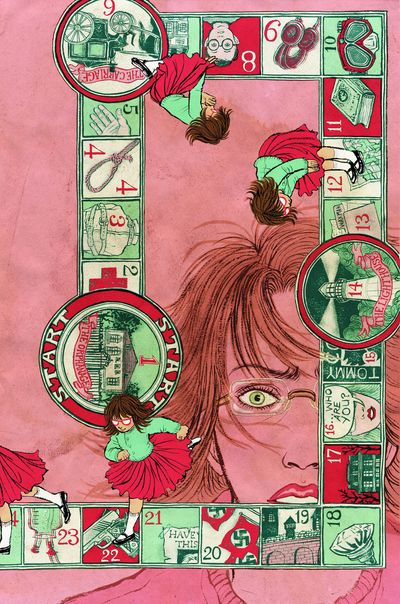Welcome to Wednesday Comics Pull-List, here on Tor.com! Every week we post reviews of a select handful of this week’s comic releases. This week features a new perspective on certain titles by the thoughtful Matt Lampert.
This week’s batch includes:
- 25 To Life #1
- Captain America: Patriot #1
- CBGB #3
- Joe The Barbarian #7
- Kodiak #1
- Morning Glories #2
- Phoenix Without Ashes #2
- True Blood #3
- The Unwritten #17
- Whispers In The Walls #2
- X23 #1
The three of us seemed to have had a really great week with our individual picks. Check out our pulls below.
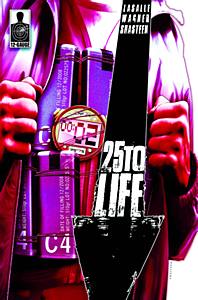 25 to Life #1
25 to Life #1
Written by Eric LaSalle and Doug Warner
Art by Tony Shasteen
(12 Gauge Comics)
Annie says: The beginning of this comic is awesome. There’s very little dialogue, but Shasteen’s artwork carries the story perfectly. We start off in a bank and see a police officer approaching the bank teller. He’s nervous, sweating, stuttering over his words and clearly in the process of robbing the bank. He leaves, is stopped by fellow officers and asked to surrender. However, as Shasteen subtly shows us, the officer is strapped with a bomb and explodes in the middle of the intersection.
And then this comic turns into an episode of [insert crime drama here]. I actually had to keep flipping back through the issue to make sure these weren’t characters I recognized. They weren’t, and I’m not sure if that makes this better or worse. Though, it must be in the “How to Write a Crime Drama” handbook that at least one police officer must be named Espinoza.
Pull?: Don’t bother.
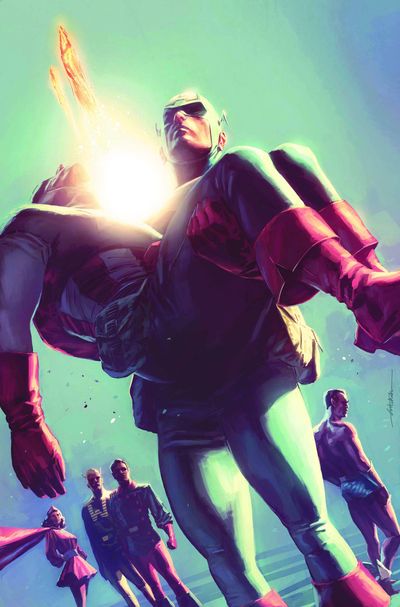 Captain America: Patriot #1 (of 4)
Captain America: Patriot #1 (of 4)
Written by Karl Kesel
Art by Mitch Breitweiser
(Marvel Comics)
Matt says: Karl Kesel and the Breitweisers give us the first of their 4-issue miniseries this week, a closer look at Jeff Mace, the third man to don the Captain America mantle. As with any first issue, the team here has to toe the line between exposition (setting up the rest of the story) and a stand-alone tale that will pull readers in. Kesel manages this feat nicely, with the first issue following Mace’s path from newspaper reporter to costumed superhero The Patriot, and through his WWII career as The Patriot up to his decision to take on the role of Cap after the untimely death of William Naslund.
The series seems to hint (right down to its title) that it will be a meditation on the role of patriotism. Mace is warned early on that the name “Patriot” has “implications—expectations” that he’ll have to be careful of; it’s a responsibility he rises to, hawking war bonds and fighting the good fight on the homefront during the war. That so much of the action takes place during World War II, however, can help keep a number of stickier political issues at bay; after all, Nazis are the bad guys history loves to hate, and so moral lines can be kept clear even when—like Mace—we’re not being “objective.” Already in the first issue, though, we see Mace mixing his pro-nationalist War activities with pro-union escapades—one can only hope that as the plot carries us beyond the (relative) moral clarity of the fight against fascism, we’ll have a chance to see our hero directly confront some of the lurking background issues. What, for example, does “patriotism” mean in the post-war 50s? Does it still align so neatly with nationalism? What does it mean to strap on an American flag, for example, as McCarthyism sweeps across the country? For whom—and in whose name—does one fight when one takes on the name “Captain America”?
It may be too soon to tell whether or not this miniseries will grapple with the tough issues. But for a first-issue read, Patriot #1 does not disappoint. The Breitweisers keep the art painterly but attractive, and the storytelling is sharp. And Karl Kesel handles words as well as he handles a pen, with a script that is both slick and well-paced.
Pull?: Absolutely; with Mace at the center of the story, and the creative team managing the trials of a first issue commendably, Patriot #1 is worth checking out.
 CBGB #3
CBGB #3
Written by Kim Krizan
Art by Toby Cypress
(Boom! Studios)
Matt says: The latest issue of these CBGB-inspired shorts is, like the first two, a fun set of irreverent tales. The first short, “Of and Concerning the Ancient, Mystical, and Holy Origins of that Most Down and Dirty 20th Century Rock‘n’Roll Club,” presents CBs as a mystical node of rock, drawing on a fantasy of Native American spiritualism to imagine an alternate history for the birth of rock and roll. The second, “Advice to a Young Artist,” plays with the gap between things that seem important at the time, and the things that seem important in hindsight. Both stories are entertaining and a quick read, and each draws in its own way on the punk mythos to capture an element of CBGB’s nostalgia.
Kim Krizan’s and Toby Cypress’s “Of and Concerning” is, on the face of it, somewhat absurd; the birth of rock and roll is re-imagined as the product of three Native Americans, each cast out of his or her tribe, coming together to make a “great noise.” In the process, the use their noise to stave off an attack, and the site of their first impromptu concert becomes the “holy place” where CBGBs will eventually stand. (CBGB is even retconned here to mean “circling bird, growling bear.”) At the heart of the tale, of course, is the central idea of Ramones-style punk: those who are outcast from their own “tribes” and under attack can band together and make a “great noise” that will found a new holy community. “Gabba gabba, we accept you, we accept you, one of us.” If, in practice, New York punk in the 70s was not always a choice between war and music (and with the latter not always overcoming the former quite so successfully), “Of and Concerning” perfectly captures the mythic idea at the heart of New York punk’s self-image.
Robert Steven Williams and Louise Staley avoid the myth-making aspects of punk in “Advice,” preferring instead to meditate on the advantages of hindsight. When a professor is asked by his student to review a CD by the band the student is considering dropping out of college to pursue, the listening session (with the help of a joint) becomes a trip into the past. Professor Stratocaster finds himself back in the 1970s, on the evening of the first performance by Nick Ryder, an artist Stratocaster tells us eventually gets signed and becomes huge. On the evening in question, however, two years before the record contract that’ll change his life, Ryder’s band sounds awful. Stratocaster apparently left the show early to pursue a threesome with his girlfriend, and ended up in a horrible breakup. Now, with the chance to relive the evening, he’s choosing to stay and listen to the band. The tale is a reminder that every artist begins somewhere—and “you can’t worry about what I think, or what your parents think, or anyone else for that matter”—even as it reminds us that judgment always has to be made in the moment, and will never have the benefit of hindsight.
Pull?: If you have any interest in rock and roll, then yes—these are two great little punk rock tales, in the very best sense of the phrase.
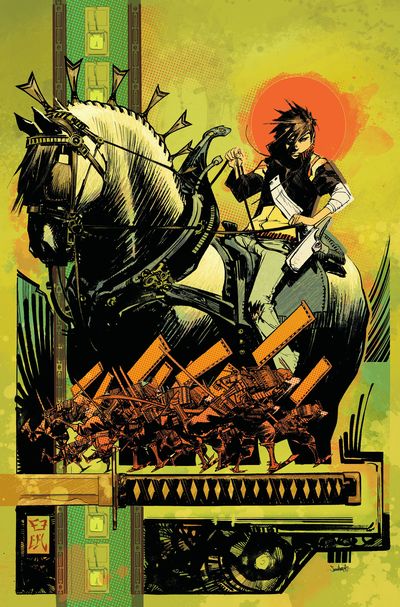 Joe The Barbarian #7 (of 8)
Joe The Barbarian #7 (of 8)
Written by Grant Morrison
Art by Sean Murphy
(DC Comics)
Matt says: Grant Morrison’s allegorical bildungsroman builds steadily toward its final issue climax next month, as the titular Joe continues to fight his way downstairs through the trippy hypoglycemic attack from hell. If you’ve been reading the series so far, you already know what to expect; the diabetic comic nerd twist on Alice in Wonderland (or The Wizard of Oz, or Labyrinth, etc.) matches action figures with a hero’s journey straight out of Campbell, and Joe is still not so much acting on as reacting to his surroundings, shuffled along each step of the way by a series of calamities and explosions.
Sean Murphy consistently delivers panels that are both incredibly intricate and yet completely clear, refusing to sacrifice either readability or detail. Murphy—a guy I knew back when we were in college—has grown significantly with each project he’s taken on (compare his work here with the short-lived Dark Horse series Crush!), and with Joe he’s really settled into a rhythm and a style that’s all his own. Morrison, meanwhile, is a writer most of us have long since learned to follow, and Joe seems to be unusually straightforward for Morrison (no breaking the fourth wall, or postmodern deconstructions here so far), without sacrificing the strength of story and thematic content that keeps us coming back for more.
Pull?: There are two kinds of comic readers: those who have already picked up Joe the Barbarian #1-6, and will therefore of course pick up issue 7; and those who for some reason have not been picking up the series, and should probably make sure they look for the trade when it comes out!
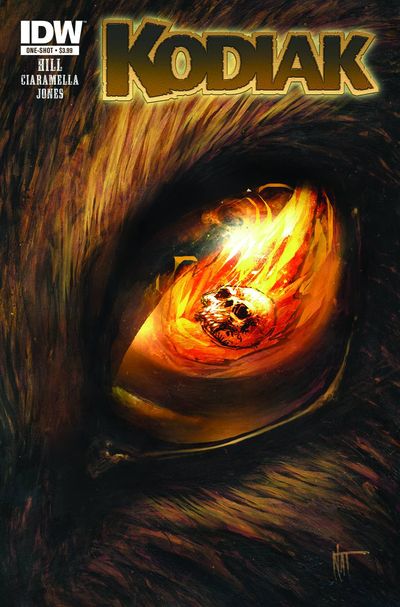 Kodiak (one-shot)
Kodiak (one-shot)
Written by Joe Hill and Jason Ciaramella
Art by Nat Jones
(IDW)
Annie says: This is another one of those guilty-pleasure comics for me. It’s short and sweet, has a clear beginning, middle, and end and even leaves you with that warm fuzzy feeling. Other than that, it’s not much of anything. The story begins almost as quickly as it ends but that’s the point of a one-shot.
Is it worth it to try and rehash the plot of this issue? I don’t think so. Just know that it has to do with a bear and it turns into a love story.
Pull?: If the last line of this review enticed you, do it. If not, don’t worry about it.
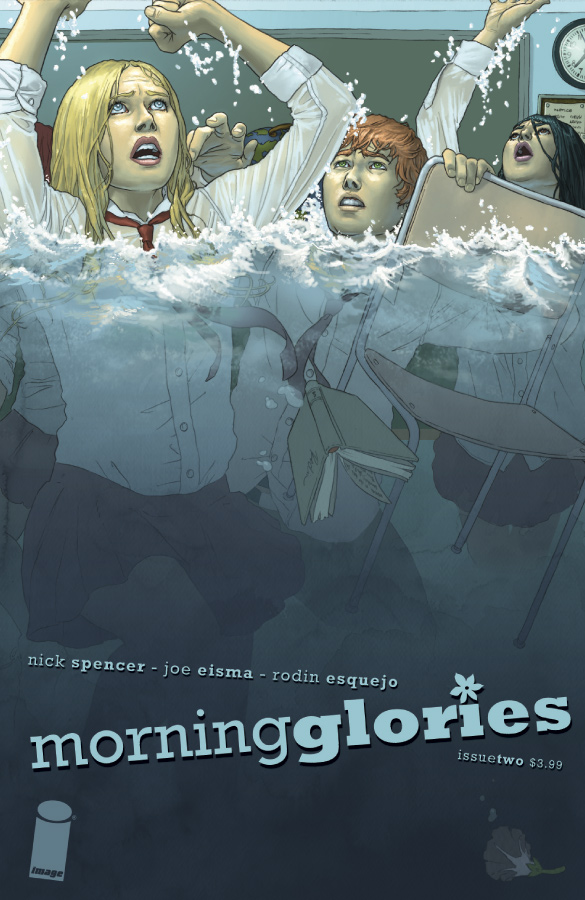 Morning Glories #2
Morning Glories #2
Written by Nick Spencer
Art by Joe Eisma
(Image Comics)
Matt says: After a wildly inconsistent double-sized debut last month, Morning Glories is still working on hitting its stride with issue #2. The “Runaways meets LOST” marketing line continues to serve as a guide here, as the narrative seems largely structured around overly-characterized teens running into situations designed to baffle the reader. This issue’s central focus, however, is Casey—the burgeoning-physicist-cum-orphan—who manages to avoid the sort of stereotypical characterizations her fellow protagonists have fallen into (the rich douchebag; the superficial bitch; the emo girl) only at the expense of being incomprehensible. Across the final page of issue #1 and the first half of issue #2, we see Casey find her parents murdered and strung up in the school’s dungeon/basement, and then beaten and repeatedly electrocuted. And yet, tossed back into the “detention room” with the rest of her classmates, Casey immediately assumes the role of strong, reassuring leader, brushing off her injuries and keeping her parents’ fate to herself. This is supposed to make her look strong. It ends up making her unbelievable. In fact, the biggest problem across Morning Glories as a whole so far—and what really, in the end, separates it from both Runaways and LOST—is that suspension of disbelief is constantly being strained to the breaking point, with little to no believability built into either the character or the world to help anchor the more fantastic elements of the plot.
Joe Eisma’s art is more consistent than it was in the first issue, though the end result continues to be lackluster thanks to the absence of an inker. In his most careful panels, Eisma’s pencils are just barely slick enough to stand on their own. The rest of the time, the linework (much like the backgrounds) simply seems unfinished and hurried. Storytelling continues to be Eisma’s main selling-point; the scenes are easy to follow and the action sequences are energetic without being overly flashy. So far, however, he’s been overshadowed by relative newcomer Rodin Esquejo, whose covers have so far been the highpoint of the series.
Only two issues (albeit 66 pages) in, it may yet be too soon to pass judgment on Morning Glories, which continues to have intriguing moments and the occasional bit of genuinely well-written characterization (the scene between Casey and Hunter in issue 1, for example). But though the transition from limited series to an “ongoing” book may have Nick Spencer feeling like he can take his time, Glories is going to have to really grab me within the next issue or two for me to stick around.
Pull?: If you liked the first issue, it may be worth picking up the second. If this summer’s Morning Glories marketing campaign hasn’t pulled you on board yet, though, you may be better off waiting to see whether the first arc is worth picking up in trade.
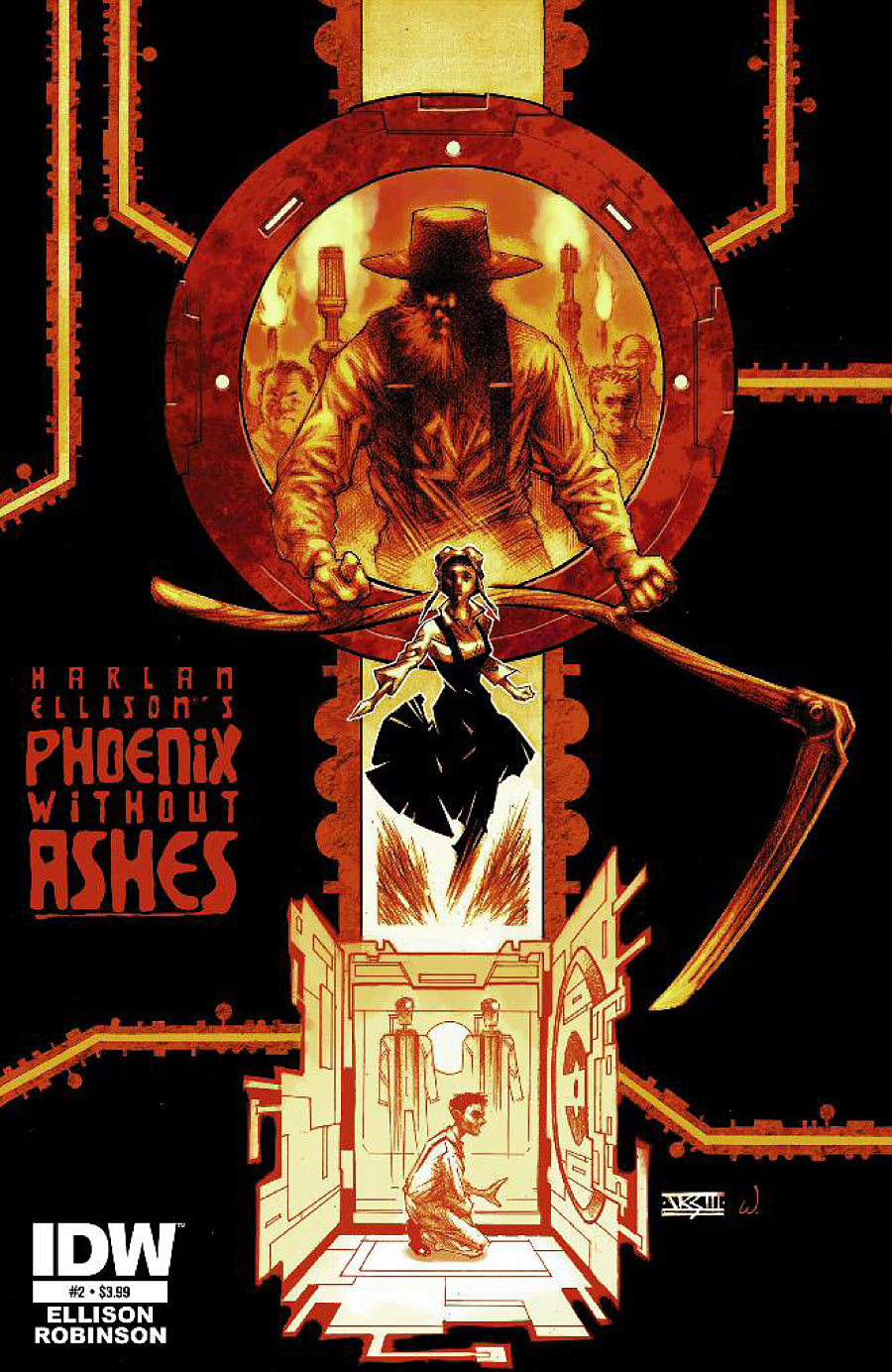 Phoenix Without Ashes #2
Phoenix Without Ashes #2
Story by Harlan Ellison
Art by Alan Robinson
(IDW)
Annie says: When a comic is done correctly, the artwork does most of the storytelling and the author uses as few words as possible to convey the story. Consider this issue the pinnacle of that tactic; it’s perfect.
I’d like to consider Harlan Ellison the Kanye West of writing. Similar to Kanye, Ellison is known for being abrasive and argumentative, but with good reason. Harlan and Kanye are masters of their craft and understand what it takes to get their messages to consumers. All press is good press; no matter what anyone says. Harlan’s lawsuits, his rebuttals to opinions he doesn’t agree with, all generate press and that’s something every author needs. Partner this with the fact that this comic is based on the TV show, The Starlost, that Harlan created and you’re set for success.
The characters in this story are a sort of very basic, non-modernized Amish folks. They live humbly but have the means to really dig into crazy amount of modern technology. The artwork really sells you on this, because when you see Devon fall into a hole, he’s not surprised by it nor is he particularly afraid. Then he’s given the ability to fly and it doesn’t freak him out either! The scene was very Alice in Wonderland for me, only a little more technologically advanced.
Pull?: Without question.
 True Blood #3
True Blood #3
Written by Mariah Huehner & David Tischman
Art by David Messina
(IDW)
Annie says: Do you guys remember what I wrote about True Blood #2, and my hopes that it would take a different route from its fantastical and, ultimately, slow moving direction? Well, this week we learn what Eric’s secret is and it’s a bit lackluster. Sam, in his “I have to solve everyone else’s problems” mindset spends most of this issue trying to figure out what Ted’s weakness is so that he can do away with him. To create a “diversion,” Tara reveals her secret and, to be honest, it’s also a little lackluster.
I’m over this comic. They’re not putting enough information in these issues to make them worthwhile. I understand that a storyline needs to be followed but it’s not like any of this stuff is mindblowing. SPOILERS: Eric’s secret was that a human sacrificed herself for him and he felt guilty about it. Tara’s secret is that her mother is a drunk and she stole drugs from one of her temporary stepfathers. Yawn. So now Sookie, Tara, and Eric have come forward with their secrets and at the end of this comic, Sam is prepared to start his. That leaves Lafayette and Bill to reveal their secrets. So, what, two more issues before we finally get to a climax with Ted? No thanks…
Pull?: Look up the summaries online and wait for Ted to leave before buying another issue.
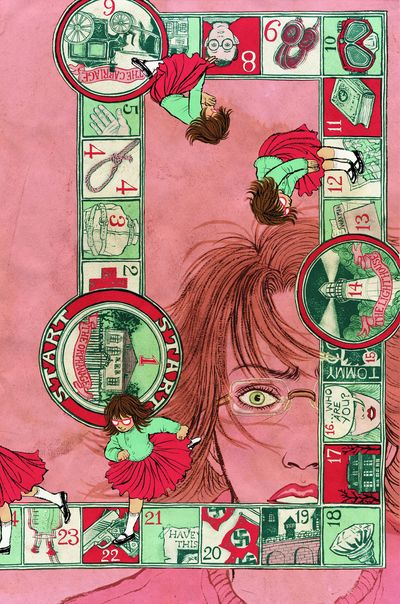 The Unwritten #17
The Unwritten #17
Written by Mike Carey
Art by Peter Gross
(DC Comics / Vertigo)
Chris says: I was lucky enough to snag this title from the very beginning and I have not been disappointed. Although the first five issues start off a little wobbly, I have a hard time imagining that Mike Carey and Peter Gross’s The Unwritten is not going to be considered a classic when it’s all said and done.
Lee Mandelo’s review of the second trade (here) is spot on, but, oh my god, Brit? You haven’t seen anything yet.
The Unwritten #17 finally gives us the back story behind the enigmatic Lizzie Hexam, following the events of the previous storyline. And in a manner befitting a series about the myriad ways the worlds of fiction and the real world mesh… it is presented in a Choose Your Own Adventure format.
From the introduction:
Shape Lizzie’s life! Bring her to the fateful moment when she meets Tom Taylor! Uncover the mysteries that lie in her past, and launch her into a new future! Or fail, and see her fall. The power, and the choice, like with you…
There’s some debate in the comic over whether Lizzie herself is a fictional character given flesh, and all three of the main characters are themselves manipulated in a story-like fashion by a larger cabal. Having the reader decide Lizzie’s fate with a Choose Your Own Adventure has us become part of The Unwritten’s story, which is absolutely devious.
I’m happy to report that the concept works really well in execution and astoundingly well thematically. The choices you make for Lizzie eventually distill down to one official ending, and even the alternate paths you take inform the character. Lizzie Hexam has been given a life that is hard to hang an identity on to, but where she could have ended up without that life is even worse.
Pull?: This is a shining example of the kind of unique story you can tell through comics as a medium. Of course you should read it.
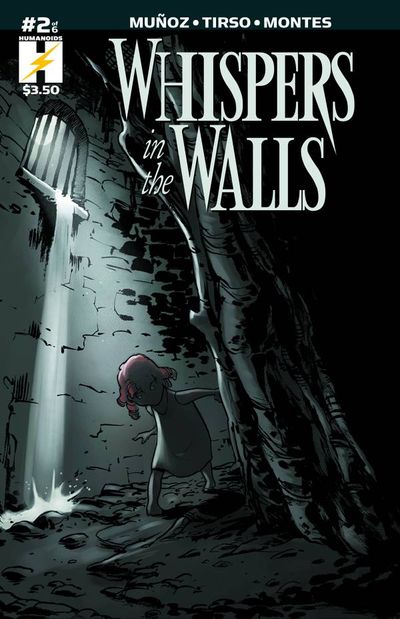 Whispers In The Walls #2 (of 6)
Whispers In The Walls #2 (of 6)
Written by David Munoz
Art by Tirso
(Humanoids)
Chris says: I was very pleasantly surprised by the first issue of this spooky series about a group of paranormal children in Czechoslovakia during World War II. And, if you recall my rundown, I was left dangling by all the questions posed by the debut issue.
These questions are answered here in a terrifying manner. The child Sarah is indeed a vampire (of sorts) and at least two of her friends possess other abilities. It turns out the medical asylum they’re in is genuinely trying to help them, but needs to be harsh in order to protect the people who work there. This is underscored heavily in a beautiful pages-long sequence as Sarah goes berserk and leaves a trail of blood and bodies from her room and out into the snow-covered forest. Tirso depicts Sarah as a sharp-edged monster of constant movement, making it all the more creepy when she finally stops to survey the damage she’s caused, perched on the edge of a ruined wall in the same manner as a kitty the then-human Sarah sought earlier in the book.
The next issues seem like they will start digging into the mythology behind Sarah’s transformation, so I hope they don’t lose the focus on the kids. The mixture of innocence and the monstrous that David Munoz and Tirso deliver in this series is potent.
Pull?: Very much yes. (Wouldn’t hurt to tell your local store to order a couple more of this series, too. I only saw one copy at mine.)
Annie says: Everyone has their own phobias. Some people are afraid of spiders, or small, enclosed areas, or water. Personally, I am afraid of anything that is smaller than me but can move faster than I can. Things like rats, mice, bugs and children. Children are especially scary because they have the capabilities to take in more information than you thought was possible. They’re constantly absorbing details of places around them, people; it’s like their little brains are constantly trying to size you up as competition. I’m not into it.
This comic introduces a group of children that are holed up in an infirmary because they all have the potential of turning into monsters. Are you kidding me? This is my worst fear on paper! The main demon-spawn, Sarah, hears a voice that is aiding in her development into a monster and keeping her safe while in the infirmary. To be blunt, this comic is creepy. Well-written is sort of an understatement. We are given so much information in a way that isn’t overpowering and doesn’t require you to flip pages to try and remind yourself of what’s happening and who everyone is. It’s really cool because as you’re learning more information about the characters, so is Sarah. The artwork is dark but the more you pay attention to the details the more you learn. This is an incredibly reader-friendly yet information-heavy comic. The storyline is just picking up in issue two and I’m definitely interested in seeing where this story goes.
Pull?: Absolutely. And pick up the prior issue while you’re at it.
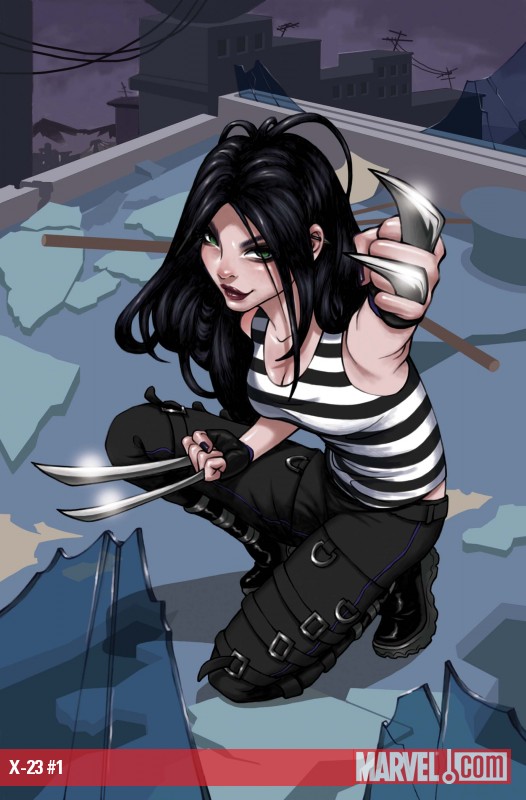 X23 #1
X23 #1
Written by Marjorie Liu
Art by Will Conrad
(Marvel Comics)
Chris says: For those unaware, X23 is a Wolverine clone in the form of a teenage girl, and has been kicking around the outskirts of the X-Men universe for a few yeas now. As one might expect from a clone bred to kill, she has never known a normal life and has a lot of trouble communicating with anyone. Think River Tam from Firefly, minus the brain implant overload craziness.
The above is basically all I knew about the character going into this book, and that’s all I needed to know. (Although a helpful origin of her is provided in the issue after the story.) Well-known paranormal writer Marjorie Liu really knocks this title out of the park, delivering an emotional young adult story about a girl trained to kill and the sizable forces arrayed against her efforts to cast off that life, both friendly and foe-ish. (Although, sadly, mostly friendly.) Liu builds this conflict methodically and comprehensively, to the point where twice I thought “I hope we get to see so-and-so addressed” only to find Liu doing so on the very next page. X23, real name Laura, has a lot of people in her life, and few of them seem to know how to treat her well.
Pull?: Wow, yes.
Chris Greenland chooses his own adventure whenever he gets dressed in the morning. He usually has to go back a page.
Annie Gala has good taste but it usually gets her in trouble.
When Matt Lampert isn’t writing about comics, he’s a philosophy professor in New York City. In between writing chapters of his dissertation, he occasionally draws comics for webzine Morbid Outlook and pass art for a local goth party. None of the above activities go very far toward paying the rent—but financial security is overrated, isn’t it?










